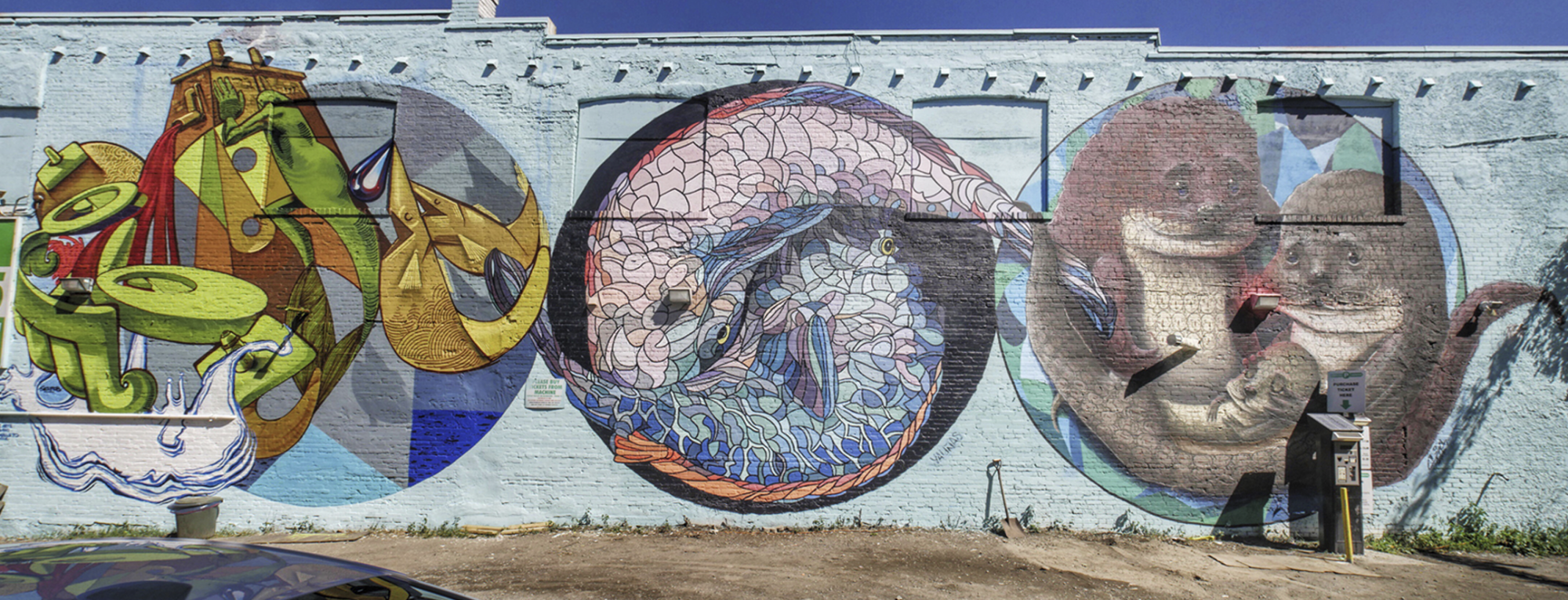Hibridación Cultural:
Cultural Hybridization:
On the east façade of the dome base, Jason Botkin composed a highly detailed work illustrating
the two distinct halves of a long integrated Mexican identity.
On the left, evoking the colonial conquest of the Spanish, we are confronted by the penetrating gaze of St. Francis of Assisi, the patron saint of the poor and of animals. To the right, sharing the same human form, but looking off into a future, sits the head of Quetzalcoatl, the “feathered serpent”. Of the traditional Mexican deities, he was the most powerful force of nature: “He was the wind; he was the guide, the road sweeper of the rain gods, of the masters of the water, of those who Brought rain” (From the Nahuatl language).
In the flanking side vignettes, an additional pair of hands impart to us the power of the yogic hand Mudras, connecting our personal vitality with the universal cosmic energy, through the position of hands held in ‘blessing’. Emanating from the flowing robes below emerge the poor and thirsty, gravely imploring us to take action in solving the collective challenges we face as a species, and reminding us that the best way to face the future is to honor and deeply understand our ancestral legacies.








The Aztec Sun Stone (or Calendar Stone)


During the creation of the murals for “Agua es Una”, an intercultural team of artists set out to bring to the world powerful messaging concering the health of water on this planet, from desert to oceans.
While falling rain is an important part of the water cycle, for a festival and the many artists encouraging paint to dry, it presented a major setback. Rising to the challenge of time constraints plus changed plans, and having only just finished an extended series of panels at the ground level, artist Jason Botkin (Canada) assembled buckets, brushes, and the support of an expert rappel safety team to cap this monumental altarpiece.
To conceptually underpin the project and its relationship to the community in a historical and contemporary context, Botkin and festival director Édgar Sánchez landed on a rendering of the Aztec calendar, with its twenty days and radiant sunshine, which now shines at the highest and most hidden part of the dome. This is a reciting an enormously complex work, conceived by an ancient culture’s greatest minds, rendered not in stone but with brush. It is a mystery that fully reveals itself only in flight, like the tens of thousands of birds that flock above this crowning piece of Foucault’s Pendulum at dusk every night.
At times, to perceive order in the chaos going on around us, we must elevate ourselves and one another, to realize a grander picture…one connecting Heaven and Earth, unifying the four pillars of heaven, and resonating with the pre-Hispanic worldview: at the navel of the Moon, in the center of the Earth, where hearts rise to the Sun.
Resting at the very the top of the dome, at the heart of the Aztec Sun Stone, Jason recreated the 4 pillars of heaven according to Mesoamerican mythology.
Before the creation of nature and the universe, there existed a Toltec diety known as
“Ometeotl”, who raised four sons, the “Tezcatlipocas”, or the four cardinal points of the cosmos. Mythology assures that thanks to them and to the sacrifice of the crocodile Cipactli, there was space to create all things and natural phenomena in the four lower levels of the sky. The pillars support the sky from the four principal points (North, South, East, West), which correspond to the four elements; water, fire, earth, and wind. Jason’s pillars also symbolize the pathways through which atmospheric forces, and particularly rain, travel.

Detai of cultural hibridation























































































